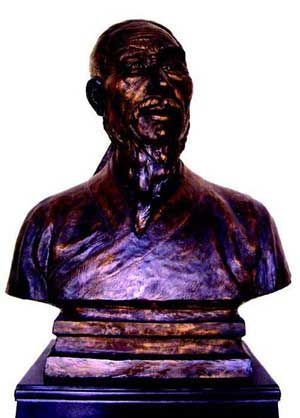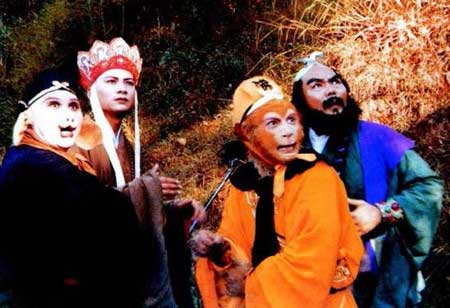- +86-13267351235
- info@globalstourtravels.com
"You carry the burden, I pull the horse. We welcome the sun as it rises, and bid goodbye as it sets. Stomp flat the bumpy road, to become the Great Way. After defeating dangers and obstacles, we set out again, and then again, from spring to summer and back again, through the many bouts of life's joys and sorrows. If you ask which way to go, the way is under your feet..This is the theme song of the TV series Journey to the West widely known in China, vividly portraying the arduous and heroic journey of Tang Monk and his disciples to the West for fetching Buddhist scriptures from the Western Heaven.
Journey to the West, a gods and demons novel representing the highest accomplishments in the history of Chinese ancient literature, is said to be written by Wu Cheng'en (c. 1500-1582) in the Ming Dynasty. "Narration about gods and demons" is the most prominent artistic characteristic of Journey to the West. The characters in Journey to the West can be mainly classified into three categories: the first is immortals, Buddhist figures and Taoist figures such as Gautama Buddha, Jade Emperor, Queen Mother of the West, Bodhisattva Guanyin, Most Exalted Lord Lao, God Erlang and Nezha; the second is mortals such as Emperor Taizong of the Tang Dynasty, Squire Kou and Marquis Shangguan; the third is monsters such as White Bone Spirit, Yellow Robe Monster, Great King of Miraculous Response, Bull Demon King, Red Boy and Scorpion Spirit. There are brilliant images with distinctive personalities in each category of characters.
Tang Monk is one of the most important characters in Journey to the West. He becomes a pious Buddhist with the monastic title of Xuanzang in his childhood. To benefit the country and all people, he leaves the Tang Dynasty's territory in the East to fetch Buddhist scriptures from the Western Heaven in spite of numerous difficulties and obstacles. On the way, he takes Sun Wukong, Zhu Bajie and Friar Sand as his disciples. Because of his adherence to the Buddhist rule of "having mercy and compassion," he gets into monsters' traps inadvertently several times. After experiencing 81 tribulations and overcoming numerous hardships and dangers, he finally obtains Buddhist scriptures and attains Buddhahood.

Wu Cheng’en
Sun Wukong is one of the most successful images shaped by Wu Cheng'en. He is originally a stone monkey formed by the coupling of Heaven and Earth. After mastering martial arts, he calls himself "Great Sage Equal to Heaven," solicits treasures from the Palace of the Dragon King, erases names in the Register of Life and Death, and creates havoc in Heaven, manifesting the rebellious spirit of resisting restraint, challenging authority, pursuing equality and emancipating personality in all aspects. This is the most prominent personal trait of Sun Wukong and the greatest charm of this image. Wu Cheng'en also described Sun Wukong's brave fight and resourcefulness in protecting Tang Monk on the road to the Western Heaven in a rich and colorful manner. With penetrating eyesight, he is capable of distinguishing truth from falsehood and is good at using the 72 methods of transformation and complicated conflicts to subdue demons.
Zhu Bajie is Tang Monk's second disciple with the monastic title of Wuneng. He is originally the Marshal of the Heavenly Canopy and is banished into the mortal world for getting drunk and flirting with Chang'e but ends up in the womb of a female boar due to are incarnation error. He is robust, strong, loyal and capable but fond of eating, averse to work and little lustful, and likes gaining petty advantages. Different from Tang Monk and Sun Wukong "having no interest in mundane affairs," the image of Zhu Bajie is a little secular and comical, deeply loved by people for long.
The monsters raping women and plundering guilty of the worst crimes depicted in Journey to the West contrast sharply with Tang Monk and his disciples. These monsters occupy hills to act as lords and take advantage of power to bully people, representing evil forces in the society of that period. Meanwhile, these monsters have different shapes, backgrounds, abilities and means. White Bone Spirit is a typical representative among them. To eat Tang Monk's flesh and obtain immortality, White Bone Spirit transforms into a beautiful woman, an infirm old woman and a benign old man, but Sun Wukong sees through the disguise immediately no matter whom it transforms into. "Sun Wukong hitting White Bone Spirit thrice" is also a classic story in Journey to the West.
The overall keynote of Journey to the West is magical, but the reality it refers to is true and profound. The author did not intend to expose the dark side of the society directly, but the objective effect was "conveying secrets in games." In the author's jeers, sarcasms and jokes, the social malpractices of that period and people disregarding law and discipline, taking advantage of power to bully people and living in extreme luxury are satirized ruthlessly. This is the realistic significance of the gods and demons novel Journey to the West different from ordinary novels.
In terms of the structure, Journey to the West consists of a total of 100 chapters, and their contents can be classified into three parts: Chapters 1-7 describe the birth of the stone monkey and havoc in Heaven; Chapters 8-12 describe the reason why Tang Monk wants to fetch Buddhist scriptures from the Western Heaven; Chapters 13-100 describe the arduous journey of Monk Tang to the Western Heaven under the protection of Sun Wukong, Zhu Bajie and Friar Sand. These three parts form an organic whole. The first and third are the key parts and the second one is mainly for plot transition.

Still of TV series Journey to the West
As a gods and demons novel, "magic" and "imagination" constitute the main artistic characteristics of Journey to the West. The first one is "magic." Journey to the West conceives a series of bizarre and magnificent scenes with not only a sense of reality, but also a sense of strangeness and vividness particular to the world of gods and demons. The author described various infinitely resourceful gods and various treasures with boundless supernatural power. Each story is full of ups and downs with clear causes and effects, and the scenes are surprisingly beautiful and eccentric. The Mountain of Flowers and Fruit is a magical scene depicted by the author:
This country is next to an ocean, and in the middle of the ocean is a famous island called the Mountain of Flowers and Fruit. This mountain is the ancestral artery of the Ten Continents, the origin of the Three Islands; it was formed when the clear and impure were separated and the Enormous Vagueness was divided...
Red cliffs and strange rocks;
Beetling crags and jagged peaks.
On the red cliffs phoenixes sing in pairs;
Lone unicorns lie before the beetling crags.
The cry of pheasants is heard upon the peaks;
In caves the dragons come and go.
There are deer of long life and magic foxes in the woods;
Miraculous birds and black cranes in the trees.
There are flowers of jade and strange plants that wither
not;
Green pine and bluish cypress ever in leaf
Magic peaches always in fruit.
Clouds gather round the tall bamboo.
The wisteria grows thick around the mountain brook
And the banks around are newly-colored with flowers.
It is the Heaven-supporting pillar where all the rivers
meet,
The Earth s root, unchanged through a myriad aeon.
The other artistic charm of Journey to the West is "imagination," i.e. its strong imaginative power. Because it is a fantasy novel on gods and demons, abundant imagination is necessary for organization of plots and shaping of characters' images. In Journey to the West, Sun Wukong, Zhu Bajie, Dragon King and numerous monsters are all images invented by the author. The author also imagined magical scenes such as infinite stretching of the gold-bound staff, the fight between the real and fake Monkey King and the 81 tribulations.
Of course, Journey to the West has shortcomings in ideological contents and artistic accomplishments. For example, in terms of thoughts, it has a strong sense of fate and reincarnation; in terms of plot designs, sometimes its description of all the 81 tribulations shows a redundant tendency. In terms of depiction of characters, the images of Tang Monk, Friar Sand, Jade Emperor, etc. are relatively insubstantial and their personalities are not demonstrated sufficiently. Among the numerous immortals, Buddhist figures, Taoist figures and monsters, few have really prominent personalities and deeply impress people.